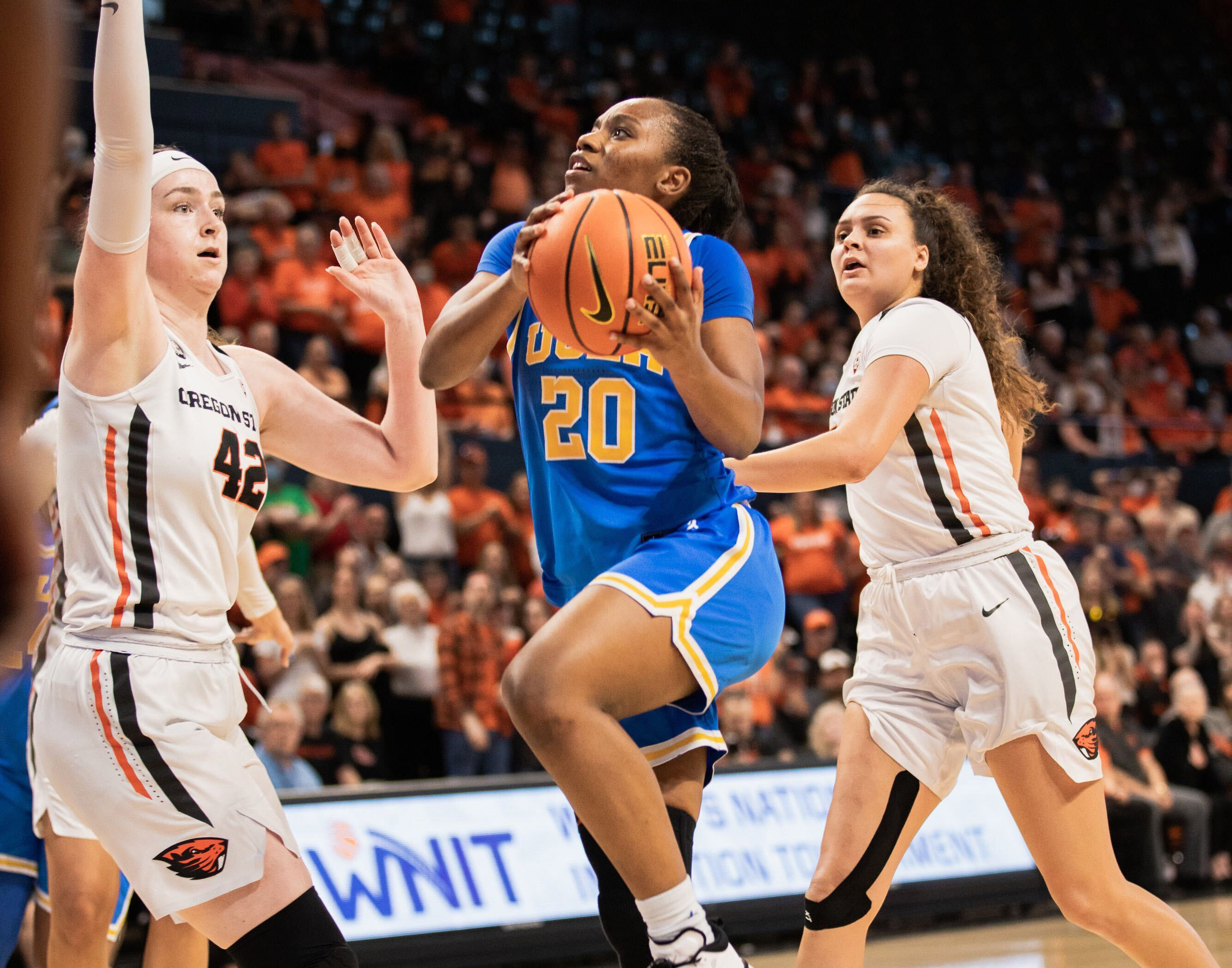This needs way more attention! It took us 3 different flights resulting in 13 hours of travel to get to Oregon 🥴 There’s no reason the WNIT shouldn’t be receiving the same benefits as the men! Why does the @NCAA own the Men’s NIT but not the @WomensNIT ? 🤔 Women deserve better! https://t.co/KwFVCbeldl
— Charisma 🦋 (@CharismaOsborne) March 27, 2022
The LOW Down: WBIT marks progress toward competitive equity in NCAA basketball

Rising fifth-year guard Charisma Osborne rises for a layup. (Courtesy of UCLA Athletics)

By Lauryn Olina Wang
July 23, 2023 3:25 p.m.
This post was updated July 23 at 6:44 p.m.
If the stars align for you to secure a ticket to Taylor Swift’s Eras Tour this summer, the most high-profile pop star in the world will serenade you about her schemes.
“I laid the groundwork, and then / Just like clockwork / The dominoes cascaded in a line,” Swift sings in the second-to-last song of her set. “What if I told you I’m a mastermind?”
While Sedona Prince likely did not set out to be a mastermind behind greater gender equity in the collegiate women’s basketball world, the then-Oregon forward catalyzed a domino effect continuing to cascade to this day.
In March 2021, Prince documented the disparities between the women’s and men’s NCAA Tournament weight rooms in a viral TikTok video. She established the groundwork that fundamentally changed the game by spurring a long-awaited conversation about equity and conferring pressure on the NCAA to act.
“When you lay the men’s and women’s championships side by side, as has been made clear over the past weeks, it is pretty self-evident that we dropped the ball in supporting our women’s athletes, and we can’t do that,” said former NCAA president Mark Emmert at the time.
In the aftermath of the commotion and calls for change, Emmert and the NCAA enlisted Kaplan, Hecker & Fink LLP to complete an external review of gender equity issues in connection with the NCAA in August 2021. The Gender Equity Commission of the Women’s Basketball Coaches Association – which UCLA women’s basketball coach Cori Close formerly served as the president of – created space for further advocacy.
Shortly thereafter, the women’s NCAA Tournament expanded to include 68 teams to level with the recent expansion of its men’s counterpart. Then, the NCAA allowed the women’s tournament to adopt the March Madness slogan and branding, changing its Twitter handles to reflect the shared ownership of the term. Once a source of viewership competition, the respective selection shows for the men’s and women’s brackets were scheduled for separate days. And the swag bags were mandated to be of equal value for both tournaments.
These efforts – valued at a cumulative $5 million in NCAA expenses – would never have rippled into reality with such urgency and vitality in the absence of Prince’s initiative. When asked in 2021 if the Kaplan report would have been commissioned without the momentum of the viral video, Close boiled it down to five words.
“The short answer is no.”
And the dominoes continue to fall.
On Monday, the NCAA announced the creation of the Women’s Basketball Invitational Tournament – an equivalent to the men’s National Invitational Tournament – as an alternative for 32 teams who do not earn bids to March Madness. The NCAA’s operation of the WBIT is a direct fulfillment of one of the recommendations highlighted in the Kaplan report, equalizing the number of postseason opportunities for men and women to 100 apiece.
The NCAA is rolling out a WBIT instead of a Women’s National Invitational Tournament because Triple Crown Sports – a private, for-profit organization unaffiliated with NCAA – owns the rights to the WNIT. Previously operating on a 64-team format, the WNIT announced it will host a field of 48 teams in the future.
The topic of equity in postseason opportunities remains particularly relevant for the Bruins, who competed in the WNIT two seasons ago and won the tournament in 2015.
UCLA’s experience vying for hosting rights, commercially traveling disjointedly to remote campuses in South Dakota and Wyoming, and funding its participation in the WNIT entirely via its own athletic department stood in stark contrast to the men’s experience in the NCAA-operated NIT. March Madness is the biggest stage in college basketball, but boarding a chartered flight to play at Madison Square Garden in the NIT Final Four – as Texas A&M men’s basketball documented two years ago – could hardly be considered a consolation.
During UCLA’s run to the WNIT Final Four in 2022, rising fifth-year guard Charisma Osborne seemingly spoke the latest development into existence.
“There’s no reason the WNIT shouldn’t be receiving the same benefits as the men! Why does the NCAA own the Men’s NIT but not the Women’s NIT? Women deserve better!” Osborne tweeted on March 22, 2022.
To address the shortcomings of the WNIT, the WBIT critically provides women’s basketball programs with unit distributions, which send money back during the tournament to the school’s conference that then gets directed towards the school itself. Programs in the NIT are being paid to play, whereas WNIT teams pay to play without a unit distribution model in place because Triple Crown Sports established the tournament as a business venture. Even the women’s NCAA Tournament lacks unit distributions.
“There’s not as much motivation for presidents, chancellors, and a lot of directors to invest in their women because even if we went to a Final Four this year, won a national championship, there would be no unit distribution back,” Close said one day after the WBIT announcement. “The men go win one or two games, and they get money back. You’re really encouraging inequity.”
Considering many athletic departments are saddled with debt, this model deepens inequity because it denies adequate incentives for universities to choose to invest in their women’s programs. UCLA is no exception, currently climbing back from a $28 million deficit in the aftermath of the pandemic and the fallout from the Under Armour sponsorship deal.
However, more promise awaits on the horizon, as ESPN’s current media rights contract with the women’s NCAA Tournament expires at the end of the 2023-2024 academic year. Supporting unit distribution in the WBIT will encourage its adoption in March Madness. Furthermore, with the precedent of unit distribution in the WBIT, bidders will have a stronger conception of market valuation, and the potential for standalone contracts – rather than the current 29-sport bundle – will drive competition within the market.
“We need to be able to show through media rights deals, through unit distribution, through TV ratings, that it’s not just the right thing to have gender equity,” Close added on Tuesday. “It’s also a really good business decision.”
Before different companies take the stage for renegotiation of the media contract next year, the WBIT has effectively set the stage for more equity, parity and opportunity to push the envelope in the women’s collegiate basketball landscape.
It is increasingly clear that no mastermind could have predicted how extensive this domino lineup would become.

